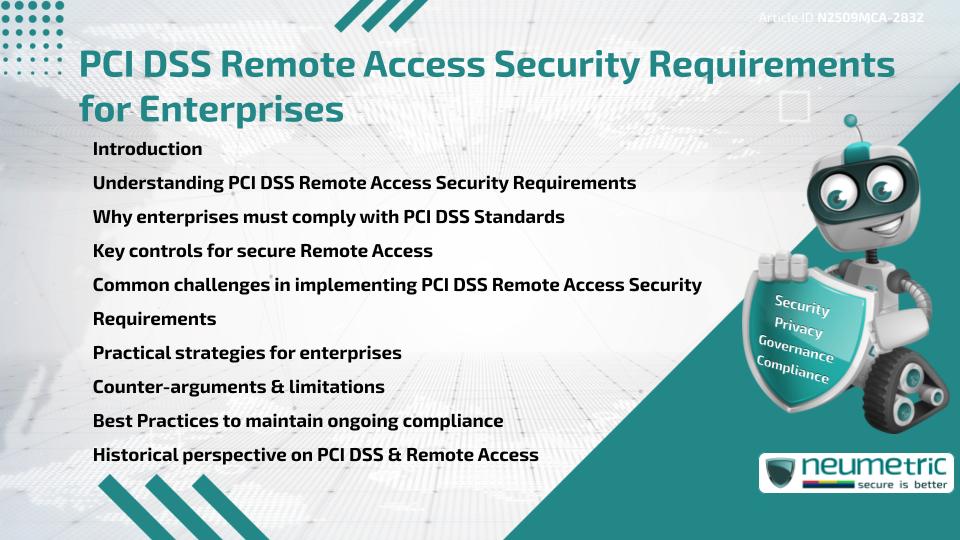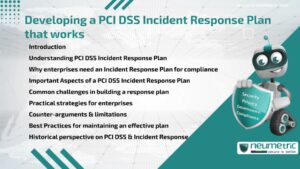Table of Contents
ToggleIntroduction
The PCI DSS Remote Access Security Requirements are a set of rules designed to protect payment card data when accessed remotely. These requirements apply to enterprises that allow vendors, Employees or Third Party providers to connect to their systems from outside the internal network. Meeting these Standards is not optional, as non-compliance can result in Financial penalties, reputational damage & data breaches. This article explores what these requirements mean, why they matter for enterprises, the key controls, common challenges & strategies to ensure compliance.
Understanding PCI DSS Remote Access Security Requirements
The Payment Card Industry Data Security Standard [PCI DSS] sets guidelines for Organisations handling Cardholder Data. Remote access is one of the riskiest points of entry for attackers, making it a prime focus in compliance audits. The PCI DSS Remote Access Security Requirements cover aspects such as multi-factor authentication, encrypted communication, unique User credentials & strict logging of remote activities. Enterprises that fail to implement these measures Risk exposing Sensitive Payment Data to unauthorized individuals.
Why enterprises must comply with PCI DSS Standards
Non-compliance with PCI DSS Remote Access Security Requirements not only invites legal consequences but also weakens consumer trust. For enterprises, compliance demonstrates responsibility in safeguarding Customer Data. Beyond avoiding fines, it builds stronger partnerships with Banks, vendors & service providers who require adherence to Industry Standards. According to the PCI Security Standards Council, maintaining compliance is essential for ensuring that payment card data remains secure across all channels.
Key controls for secure Remote Access
The main controls under PCI DSS Remote Access Security Requirements include:
- Multi-factor authentication to verify User identity.
- Strong password Policies that prevent weak or reused credentials.
- End-to-end encryption of data transmitted during remote sessions.
- Session timeouts to prevent unauthorized access if a session is left open.
- Logging & monitoring to detect suspicious behavior.
These measures collectively ensure that only authorized individuals access sensitive systems while leaving behind auditable trails for investigators.
Common challenges in implementing PCI DSS Remote Access Security Requirements
Enterprises often face obstacles when implementing these requirements. Legacy systems may not support modern authentication methods. Remote Employees might resist additional authentication steps due to convenience concerns. Budget constraints can also limit investment in advanced Security tools. Despite these challenges, enterprises must prioritise compliance, as attackers often target the weakest Security link.
Practical strategies for enterprises
To successfully meet PCI DSS Remote Access Security Requirements, enterprises should:
- Regularly train Employees on secure Remote Access practices.
- Conduct periodic penetration tests to identify weaknesses.
- Work with vendors who demonstrate PCI DSS Compliance.
- Use centralized identity & access management solutions.
Resources such as NIST CyberSecurity Guidelines provide useful Frameworks that can complement PCI DSS Compliance efforts.
Counter-arguments & limitations
Some critics argue that PCI DSS Remote Access Security Requirements create additional costs without guaranteeing absolute Security. While it is true that no system is completely breach-proof, PCI DSS Standards establish a minimum baseline of protection. Without them, enterprises would face even greater Risks of data theft & non-compliance penalties.
Best Practices to maintain ongoing compliance
Compliance is not a one-time task. Enterprises should:
- Continuously monitor Remote Access logs.
- Update Security Policies to reflect evolving Threats.
- Engage external Auditors to validate compliance.
- Regularly review & update authentication methods.
Historical perspective on PCI DSS & Remote Access
The PCI DSS Framework was introduced in the early 2000s in response to rising payment card fraud. Initially, Remote Access was not a primary concern, but as enterprises adopted global workforces & Third Party vendors, Remote Access emerged as a critical attack vector. Over time, PCI DSS evolved to strengthen requirements around remote connections, reflecting the changing nature of digital Threats.
Takeaways
- PCI DSS Remote Access Security Requirements are mandatory for enterprises handling Cardholder Data.
- Non-compliance can lead to penalties, breaches & reputational harm.
- Key measures include multi-factor authentication, encryption & monitoring.
- Despite challenges, practical strategies & training can ensure compliance.
- Ongoing vigilance is essential as Threats continue to evolve.
FAQ
What are PCI DSS Remote Access Security Requirements?
They are rules that ensure secure connections for Employees, vendors & third parties accessing payment systems remotely.
Why is Remote Access considered high Risk?
Because attackers often exploit weak remote Access Controls to steal sensitive payment card data.
Do all enterprises need to comply with PCI DSS Remote Access Security Requirements?
Yes, any enterprise that stores, processes or transmits Cardholder Data must comply.
What tools help enterprises meet these requirements?
Identity Management Platforms, Multi Factor Authentication Tools & Centralised logging Systems support Compliance.
How often should enterprises review their remote Access Controls?
Controls should be reviewed at least annually or whenever significant system changes occur.
Are Third Party vendors also required to follow these requirements?
Yes, Vendors connecting remotely to enterprise systems must comply with the same Security Standards.
Does PCI DSS Compliance guarantee complete Security?
No, but it establishes a strong baseline of protection that significantly reduces Risks.
References
- PCI Security Standards Council – PCI DSS Overview
- NIST – CyberSecurity Framework
- ISACA – IT Audit and Assurance
- Council of Europe – Data Protection and Privacy
Need help for Security, Privacy, Governance & VAPT?
Neumetric provides organisations the necessary help to achieve their CyberSecurity, Compliance, Governance, Privacy, Certifications & Pentesting needs.
Organisations & Businesses, specifically those which provide SaaS & AI Solutions in the Fintech, BFSI & other regulated sectors, usually need a CyberSecurity Partner for meeting & maintaining the ongoing Security & Privacy needs & requirements of their Enterprise Clients & Privacy conscious Customers.
SOC 2, ISO 27001, ISO 42001, NIST, HIPAA, HECVAT, EU GDPR are some of the Frameworks that are served by Fusion – a SaaS, multimodular, multitenant, centralised, automated, CyberSecurity & Compliance Management system.
Neumetric also provides Expert Services for technical Security which covers VAPT for Web Applications, APIs, iOS & Android Mobile Apps, Security Testing for AWS & other Cloud Environments & Cloud Infrastructure & other similar scopes.
Reach out to us by Email or filling out the Contact Form…





